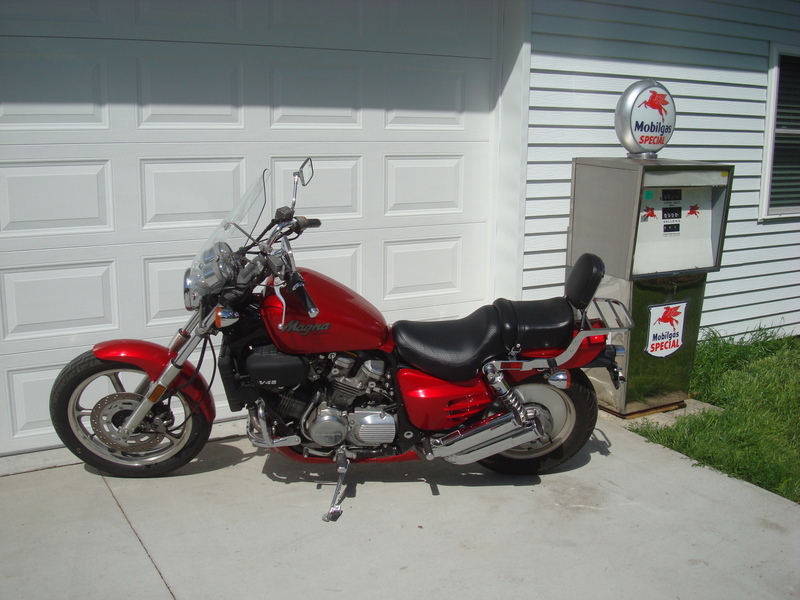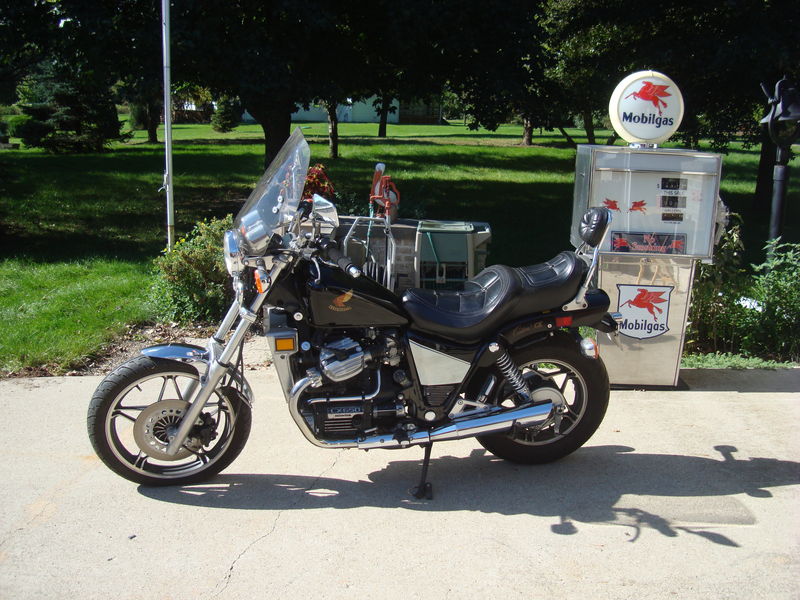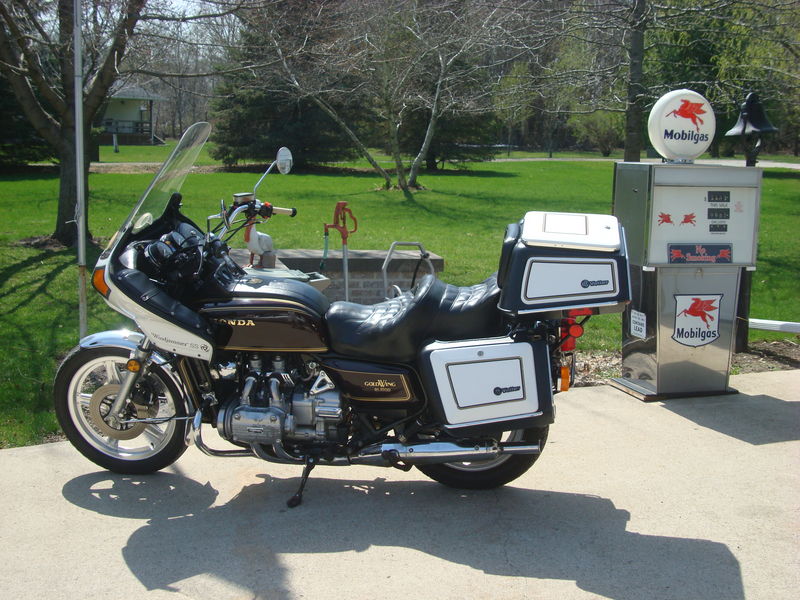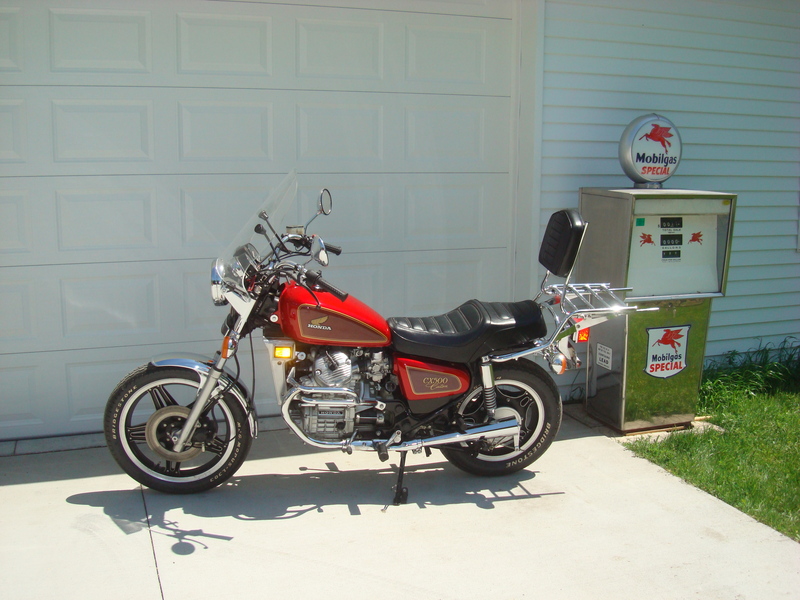Photo 2
Current collection and Details
1988 Honda VF750C "Super Magna"
1988 Honda VF750C "Super Magna"
The second generation Magna of '87-'88 was dubbed the Super Magna by aficionados of the bike, though it was not an official Honda name. In 1987, the 700 cc engine produced 80 bhp (60 kW) @ 9,500 rpm, with torque being 46 ft·lbf (62 N·m) @ 7,500 rpm. In 1988, the Magna grew back to its original size of 748 cc.
The 1987 V45 Magna was available in either Candy Wave Blue or Candy Bourgogne Red (1988 dropped Blue in favor of Black). For 1987, the fake airbox covers were wrinkle black with a "Magna" emblem. The fake airbox emblem changes to "V45" for the 1988 model.
The 1987 Super Magna had a silver, grey & black Honda "wing" tank decal, while the 1988 model had a silver "MAGNA" tank decal.
The exhaust system was now an upswept 4-into-4 set of pipes, truly unique in the cruiser world. Although the exhaust pipes were a beautiful sight, they were not friendly to the use of saddlebags as they were too high. The rear wheel was a solid aluminum disc. The chin fairing was unfinished black plastic for the 87, and color-matched for the 88. The second generation was also the first to have the lower seat height of a mere 27.8 inches (706 mm), more than 4 inches (102 mm) lower than its predecessor. A total of 16,000 units were built for the 1987 model year, while only 3500 were built for 1988. (1987 starting SN JH2RC280*JA100001)
1983 Honda CX650C This one year model was offered in two colors, Black and Candy Wineberry Red
The CX650 Custom was a one year model produced in 1983 for the US market. Its unique cruiser type styling sets it apart from all other CX variants. The frame is completely different, and the styling was marketed to accommodate the American desire for the low stretched look of American cruiser bikes. Its semi chopped fork, tear drop tank, low seat and truncated exhaust gave it a very rakish and appealing look. However, it was very similar in styling and price range to the 750 Shadow and Honda elected to have only one cruiser bike in that class, thus the reason for its short model life. SOLD in December 2017 $1500.00
1981 Honda CM400A
The Honda CM400 was a street bike produced by the Honda Motor Company from 1979 to 1982, part of a series of motorcycles with the prefix 'CM' using various engine capacities. It was a precursor to the Honda Rebel series of motorcycles. The bike had a 395 cc (24.1 cu in) air cooled parallel twin cylinder engine. It was equipped with electric start and electronic ignition. Models included the CM400A (Automatic), CM400C (Custom), CM400E (Economy) and CM400T (Tach).
The Honda CM series all generally resembled the older-style flat-seat bikes from the 60s and 70s, with the exception of a slightly raised passenger area seat and small plastic fairings for the battery and electrical. These are "standard" style motorcycles but do have some elements of the cruiser (stepped seat, increased fork angle, extra chrome).
The CM400 series includes only a speedometer and three indicator lights (neutral, oil pressure, high beam) with a tachometer for the C and T models. The E (economy) model had wire wheels and drum brakes, while the others had Comstar wheels and a front disk/rear drum braking setup. While not particularly powerful, the CM400's handling makes it one of the great starter bikes.
Many engine components are common with the Honda CB400T models from the same year. The parallel twin engine has three valves per cylinder (two intake, one exhaust) and a five-speed manual or two-speed automatic transmission. In 1982, the CM engine was bored out to a 447 cc engine with six gears, and the series was renamed CM450.
1990 Honda Pacific Coast PC800
The PC800 Pacific Coast is a touring motorcycle manufactured and marketed by Honda between 1989 and 1998. Named after California's Pacific Coast Highway, over 14,000 were sold in North America, Europe and Japan, with a three-year hiatus between two production runs. The bike is noted for its single integrated trunk straddling the rear wheel, full bodywork, and distinctive two-tone paint.
Like the earlier Honda Goldwing[1] and later Rune,[2] the Pacific Coast had been conceived and designed by Honda Research America specifically for the US market. Though subsequent Honda motorcycles would feature integral, side-opening trunks — namely the Deauville/NT700V, ST1100, Gold Wing andST1300 — the wheel-straddling, top-opening trunk concept remained unique to the Pacific Coast.
According to a 1998 Motorcycle.org article, "when the PC debuted, it was considered a radical bike."[4] The PC800 departed convention with its integral trunk, extensive bodywork and marketing aimed at the "white-collar professional."
In addition to naming the PC800 after an important American highway, Honda reinforced the association between the motorcycle and other notable highways of the world; advertising copy from the 1994 Pacific Coast brochure highlighted the famed Amalfi Drive and Blue Ridge Parkway, along with, of course, the Pacific Coast Highway.[5]
Similarly, the name of the lower body color for 1996 model referred to another important road, the Karakorum Highway, the highest international highway in the world.
In contrast to motorcycling advertising that emphasized rebellion or exaggerated masculinity, a 1989 30-second introductory television commercial for the PC800 depicted a couple awakening at a stylish waterfront home. She is seen running on the beach, he is seen showering, lifting his Rolex-like wrist watch from the bedside table, fixing coffee – all with a Honda PC800 next to a grand piano in their elegant living room, the waves crashing visibly beyond. The commercial ended with a single shot of the motorcycle at a very calm (i.e., pacific) shoreline carrying the voiceover: "Introducing the Pacific Coast, from Honda. It is the beginning of a new day."
Sales over the entire two-part production run averaged under 1,400 sales per year over ten years.
Unlike other motorcycles that offer detachable side or top cases for storage, the PC800 has an integral waterproof trunk under the pillion (passenger seat). The passenger seat is attached to a single trunk lid that hinges upward to reveal two storage areas that straddle the rear wheel — with sufficient capacity to carry "two full-face helmets and two medium-sized gym bags",[4] or "two grocery bags", or "four plastic bags full of groceries, along with a small bag of dog food."[4] The trunk lid is held up by a hydraulic strut and is controlled by a release mechanism under the lockable fuel filler door.
Like other motorcycles with full bodywork, the PC800's plastic bodywork conceals almost the entirety of the motorcycle's mechanical underpinnings — in the manner of a scooter. While routine oil changes do not require panel removal the PC800owners manual calls for removal and replacement of four panels (two each side) for servicing the spark plugs and seven panels for servicing the battery.
The design of the bodywork includes three vents (visible in the photo above) on each side of the bike to cool the mechanicals: a pair of forward vents on the wheel cowling, a lower vent on each side for the transmission, and two larger vents to accommodate the engine's cooling system.
In contrast to other motorcycles with full bodywork, the PC800's trunk occupies the full unbroken width of the bike's tailend while the front wheel carries a partial cowling, which reverted to an open fender in 1997-1998 model years. For the entire production run, the bodywork featured a lower-body accent color.
Honda outfitted the Pacific Coast as a "low-maintenance motorcycle for daily use" aimed primarily toward first-time motorcycle owners. Riding position is standard or neutral, instrumentation is "automobile-like,"[4] switches and controls are large and clearly marked, self-canceling turn signals were included until the 1997 model year along with a seat height of 30.1 inches (760 mm) and an integrated fairing and windshield. 1989 and 1990 models offered an optional AM/FM radio. Sold in 2017 $3200.00
1979 Honda Gold Wing GL1000
Honda GL1000 Gold Wing
Years produced: 1975-1979
Claimed power: 80hp @ 7,500rpm
Engine type: 999cc single-overhead cam, two valves per cylinder, water-cooled flat four
Weight: 650lb
Price then: $2,895
Price-point analysis is an unrefined art, dedicated to the unvarnished truth of the bottom line. If the cost of any piece of the product can be reduced without harming its function, it’s done. In our industry it boils down to the MSRP (Manufacturer’s Suggested Retail Price) of the envisioned competition; in 1975 the Harley-Davidson Electra Glide cost $3,555, (with bags and fairing standard); the BMW R90/6, $3,395; the Moto Guzzi 850-T, $2,699; and the Kawasaki Z1, $2,475. Honda slotted its planned new model right in the middle at $2,895.
The GL1000 Gold Wing (the name came from the Honda logo, a golden wing) introduced in late 1974 had a 999cc opposed four-cylinder engine, a wheelbase of 60.6in and a curb weight of 650lb. There was little truly remarkable or innovative about the GL1000, yet it was so well executed it seemed like the Gold Wing represented a new frontier in motorcycle technology.
Take, for instance, the Gold Wing’s liquid cooling. Scott motorcycles in England had been water cooled for over half a century, right up to the mid-1960s, and Colonel H.C. Holden of the Royal Engineers had his water-cooled, flat-four-powered motorcycle on the market in 1900. And then there was the Suzuki GT750, a liquid-cooled in-line triple, presented in 1971.
Then there was the matter of operating the overhead camshafts, one on each bank of cylinders. Bevel-driven overhead cams had been around since before World War I, followed by chain-driven and gear-driven cams, but in 1975 toothed rubber and fabric timing belts were a decided rarity. The 1971 Moto Morini 3-1/2 Sport used a short belt to turn the camshaft in its OHV V-twin, and in 1975 Ducati was already planning to use belts in its OHC V-twins. Belts are both less expensive and quieter than chains or gears, the only drawback being the need to change belts before they wear out and break. On the Wing this is an easy job, done by removing the front cover from the engine.
An interesting touch is a gear-driven alternator rotating in the opposite direction of the crankshaft, helping to counter-balance the slight sideways surge of the longitudinal crankshaft when the throttle is blipped at rest, a phenomenon that BMW riders know well.
Also, a cush drive is fitted aft of the crankshaft, reducing the jerkiness that can result from abrupt on/off throttle action. The idea was to deliver power smoothly. Another interesting feature is the complicated linkage operating the four 32mm Keihin carburetors, allowing one cable to open and close the quartet.
Then there’s the gas tank sitting under the seat, with the mechanical fuel pump’s drive coming off the end of the right-side camshaft. Carrying 5gal of gas up high would give the rider 35 extra pounds to balance, but down low it helps to centralize mass. This is a big bike, and Honda wanted to reduce any balance issues to their most manageable proportions.
To keep the wheelbase within acceptable lengths, the multi-plate wet clutch and five-speed transmission are tucked under the engine. A Hy-Vo chain provides primary drive, and a shock-absorbing system is built into the countershaft sprocket and connected to a shaft final drive. This was a first for Honda, who wanted to make absolutely sure the drive shaft assembly aided in the smoothness of power delivery; the Wing’s drivetrain was tested for a full year before it was shown at the 1974 show in Cologne, Germany.
The rear wheel on the GL1000 was a smallish 17in, but with a fat 4.0in tire like the Harley. It also sported a disc brake, a relative novelty, and people oohed and aahed over that fact, not appreciating that Harley had been using one for several years. The front wheel was a more standard 19in, with dual discs.
The Gold Wing was a wild success; according to Honda over 97,000 GL1000s were sold in this country from 1975 through 1979. And come 1980, major changes were in order. The original, Japanese-made GL1000 was replaced by the new GL1100, built at the new Honda plant in Marysville, Ohio. It was now a real American motorcycle. Sold in 2017 $1000.00
1981 CX500C, less than 800 original miles
The Honda CX series motorcycles, including the GL500 and GL650 variants, were developed and released by Honda in the late 1970s, with production ending in most markets by the mid 1980s. The design included innovative features and technologies that were uncommon or unused at the time such as liquid cooling, electric-only starting, low-maintenance shaft drive, modular wheels, and dual CV-type carburetors that were tuned for reduced emissions. The electronic ignition system was separate from the rest of the electrical system, enabling the motorcycle to be push-started and ridden in case of a total electrical system failure.
The CX series feature a crankshaft configuration aligned longitudinally with the axis of bike, similar to the Moto Guzzi layout. Unlike a "boxer" flat-twin, the cylinders protrude at an angle above the horizontal. The included angle of the CX is 80°, and the heads are twisted 22° so that the inlet tracts do not interfere with the rider's legs. A camshaft nestles at the base of the V between the cylinders. Although Honda generally favors OHC engines, the cylinder head twist necessitated the use of stubby pushrods to operate the four overhead valves per cylinder, with a forked rocker arm acting off each pushrod. The 5-speed transmission is located below the crankshaft, with both in the same housing, an arrangement which keeps the engine short (length wise) but quite tall. The engine has a 10.0:1 compression ratio and 9,650 rpm redline. Just as with the Honda Gold Wing, the transmission spins contrariwise to the engine's rotation to help counteract the engine torque's tendency to tip the bike slightly to one side when the throttle is opened or closed.
The CX was the first V-twin motorcycle that Honda ever built. It was initially designed as a 90 ° V-twin. Honda built a prototype CX350 but it was never released to the public. In that version the cylinder heads did not have the cylinder-head twist
Final drive is via a shaft. Power is transferred via an enclosed splined driveshaft with one universal joint. The shaft drives a bevel gear to which the wheel is joined via a cush-drive, which absorbs and dampens driveline shocks and vibrations. The bevel drive spins in an oil bath, and a grease-nipple is provided for greasing the shaft bearing.
The ComStar wheels combine the flexibility of spoked wheels with the strength and tubeless characteristics of one-piece wheels. Honda introduced the Com-Star wheels a year or so earlier on the CB250T/400T Dream as well as on the CB750F2 and GL1000 Gold Wing, although these featured standard rims that demanded inner tubes to be used.
Early versions had conventional suspension, consisting of hydraulically damped telescoping front forks and dual coil-over shocks at the rear. Later versions had air-assisted forks and featured Honda's Pro-Link monoshock rear suspension. US bikes (except GL500I, GL650I and Turbo) were equipped with a single front disc brake whereas all other bike possess dual front disc brakes. Besides the 'vanilla' CX500B, models after 1980 sport dual piston calipers replacing the single piston caliper of the earlier models. For the Turbo and Eurosport models the rear drum was replaced with a dual piston caliper and disc. All models feature steel tube frames with a large backbone, with the engine used as a stressed member. The dual shock models use a single tube backbone whereas the later Pro-Link models employed a triple tube backbone.
The "Custom" variant, introduced in 1979, had a smaller, narrower tank and buckhorn handlebars. The headlight and gauges were similar to the CX500 Deluxe. Turn signals were now mounted along the fork tubes, below the level of the headlight. 1982 was the last model year for the CX500. In 1983 it was bumped up to 673 cc and became the CX650. The CX650's styling was different, and the engine was painted black instead of silver.
.





